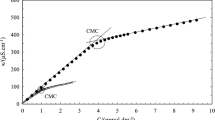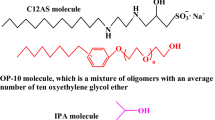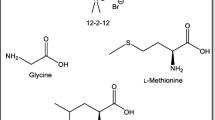Abstract
The interactions of polyelectrolyte poly (sodium styrene sulfonate or NaPSS) and anionic surfactants, sodium glycodeoxycholate (SGDC) and sodium tetradecyl sulfate (STS), as well as their combination (SGDC + STS) at different mole fraction ratios, were investigated using surface tension analysis. In the SGDC + STS binary mixture, when the amount of NaPSS (0.005–0.03%) increased from \({\alpha }_{{\text{SGDC}}}\) 0.0 to 1.0, increasing the critical micellization concentration (cmc) of the mixtures. The minimum cmc values were found from 0.833 to 1.480 mmol L−1 in the presence of 0.03% of NaPSS. Clint, Rubingh, Motomura, and Rodenas approaches were used to evaluate the ideal cmc, activity coefficients (fi), interaction parameter (–β), micellar compositions (x), and ideal micellar composition of (xid) of SGDC + STS mixtures. Synergism has been demonstrated by the experimental values of c0m being lower than the ideal values in water. Moreover, by adding NaPSS from 0.005 to 0.03%, the synergism interaction was eliminated and antagonism behavior was developed. The standard Gibb’s free energy of micellization (\({\Delta G}_{m}^{0})\) and surface excess (Γ) and surface area per absorbed molecules (Amin) was decreased or increased depending on NaPSS amount in the SGDC + STS mixture with varying \({a}_{{\text{SGDC}}}\).






Similar content being viewed by others
Data availability
No datasets were generated or analysed during the current study.
References
Yang J, Pal R (2020) Investigation of surfactant-polymer interactions using rheology and surface tension measurements. Polymers 12:2302
Gradzielski M (2023) Polymer–surfactant interaction for controlling the rheological properties of aqueous surfactant solutions. Curr Opin Colloid Interface Sci 63:101662
Srivastava A, Elahi D, Kumar M, Raghav S, Singh OG, Singh N (2023) Binding influence of sunset yellow dye on the sodium tetradecyl sulphate micelles in the presence of sodium carboxymethyl cellulose medium. J Mol Liq 385:122375
Kumar M, Raj S, Thapa U, Singh S, Srivastava A (2021) Investigation the effect of sodium carboxymethylcellulose as polycounterion on cetirizine hydrochloride–sodium dodecyl sulphate mixed micelle. J Mol Liq 322:114973
Anacker EW, Underwood AL (1981) Organic counterions and micellar parameters. n–alkyl carboxylates. J Phys Chem 85:2463–2466
Hansson P, Almgren M (1996) Interaction of CnTAB with sodium (carboxymethyl) cellulose: effect of polyion linear charge density on binding isotherms and surfactant aggregation number. J Phys Chem 100:9038–9046
Zelikin AN, Trukhanova ES, Putnam D, Izumrudov VA, Litmanovich AA (2003) Competitive reactions in solutions of poly-l-histidine, calf thymus dna, and synthetic polyanions: determining the binding constants of polyelectrolytes. J Am Chem Soc 125:13693–13699
Bhattarai A (2019) Micellization behavior of cetyltrimethylammonium bromide in the absence and presence of sodium polystyrene sulfonate in water and methanol-water mixture: a conductivity approach. J Mol Liq 292:111352
Mahjoub HF, Aouissi Z, Othman T (2018) Influence of carboxymethylcellulose (NaCMC) on the aggregation and micellization behaviors in aqueous cethylpyridinium chloride solutions: thermodynamic study and effect of polymer concentration. J Mol Liq 265:473–486
Das B, Ray D, De R (2014) Influence of sodium carboxymethylcellulose on the aggregation behavior of aqueous 1-hexadecyl-3-methylimidazolium chloride solutions. Carbohyd Polym 113:208–216
Almgren M, Hasson P, Mukhtar E, Stam JV (1992) Aggregation of alkyltrimethylammonium surfactants in aqueous poly(styrenesulfonate) solutions. Langmuir 8:2405–2412
Taylor DJ, Thomas RK, Hines JD, Humphreys K, Penfold J (2002) The adsorption of oppositely charged polyelectrolyte/surfactant mixtures at the air/water Interface: neutron reflection from dodecyl trimethylammonium bromide/sodium poly(styrene sulfonate) and sodium dodecyl sulfate/poly(vinyl pyridinium chloride). Langmuir 18:9783–9791
Skerjanc J, Kogej K, Vesnaver G (1988) Polyelectrolyte-surfactant interactions: enthalpy of binding of dodecyl- and cetylpyridinium cations to poly(styrenesulfonate) anion. J Phys Chem 92:6382–6385
Hayakawa K, Kwak JCT (1982) Surfactant-polyelectrolyte interactions. 1. Binding of dodecyltrimethylammonium ions by sodium dextransulfate and sodium poly(styrenesulfonate) in aqueous solution in the presence of sodium chloride. J Phys Chem 86:3866–3870
Rub MA (2020) Effect of additives on the aggregation phenomena of amphiphilic drug and hydrotrope mixtures. J Mol Liq 298:112049
Rub MA (2020) Effect of gelatin protein on self-association behavior of sodium salt of ibuprofen drug in urea solution. J Mol Liq 298:112039
Rub MA (2018) Effect of additives (TX-114) on micellization and microstructural phenomena of amphiphilic ibuprofen drug (sodium salt): multi-technique approach. J Luminescence 197:252–265
Thalberg K, Lindman B (1993) Segregation in aqueous systems of a polyelectrolyte and an ionic surfactant. Colloids Surf 76:283–288
Lindmana B, Antunesb F, Aidarovac S, Miguelb M, Nylandera T (2014) Polyelectrolyte-surfactant association– from fundamentals to applications. Colloid J 76:585–594
Wills PW, Lopez SG, Burr J, Taboada P, Yeates SG (2013) Segregation in like-charged polyelectrolyte–surfactant mixtures can be precisely tuned via manipulation of the surfactant mass ratio. Langmuir 29(14):4434–4440
Bai G, Nichifor M, Lopes A, Bastos M (2005) Thermodynamic characterization of the interaction behavior of a hydrophobically modified polyelectrolyte and oppositely charged surfactants in aqueous solution: effect of surfactant alkyl chain length. J Phys Chem B 109:518–525
Zhang Q, Kang W, Suna D, Liua J, Wei X (2013) Interaction between cationic surfactant of 1-methyl-3-tetradecylimidazolium bromide and anionic polymer of sodium polystyrene sulfonate. Appl Surf Sci 279:353–359
Liu QC, Zhang QH, Ren ZH, Deng ZP, Wu QL, Wang JQ (2024) Effect of glycerol on micellization of quasi-binary mixture of zwitterionic cocamidopropyl hydroxysultaine and cetyltrimethylammonium bromide in aqueous solution. Colloids Surf A 683:133063
Zhang QH, Sheng R, Ren ZH, Huang J, Wang YX, Wang BR, Huang XL, Cheng Q, Wu XM, Wang TB (2023) Interaction and micellar behavior of ternary mixture of amphoteric amino sulfonate surfactant with traditional anionic and nonionic surfactants: effect of hydrophilicity. J Ind Eng Chem 120:487–494
Yang Y, Li BB, Ren ZH, Long QL, Wang BR, Wang N, Wang YX, Tian H, Zhang XM, Yuan J, Guo BB, Huang XL, Ma HJ, Cheng Q, Zeng K, Luo H (2022) Role of core-shell structure in binary mixture of amino sulfonate amphoteric surfactant with nonionic surfactant in solubilization behavior of pyrene. Colloids Surf A 644:128874
Li DN, Long QL, Ren ZH, Wang BR, Wang YX, Li BB, Yuan J, Wang N, Zhang XM, Tian H, Huang XL, Ma HJ, Guo BB, Zeng K, Cheng Q, Luo H, Pan ZY (2022) Synergistic behavior of amphoteric amino sulfonate with coconut-based polyoxyethylenated sulfate in water-glycerol solution. J Mol Liq 358:119201
Sheng R, Ding QY, Ren ZH, Li DN, Fan SC, Cai LL, Quan XF, Wang Y, Yi MT, Zhang YX, Cao YX, Wang H, Wang JR, Zhang QH, Qian ZB (2021) Interfacial and micellization behavior of binary mixture of amino sulfonate amphoteric surfactant and octadecyltrimethyl ammonium bromide: effect of short chain alcohol and its chain length. J Mol Liq 334:116064
Sheng R, Quan XF, Ren ZH, Huang J, Li DN, Wang JR, Qian ZB, Zhang YX, Cai LL, Li BB, Yi MT, Zhang QH, Tian H, Wang BR, Yuan J, Wang N, Wang YX, Long QL, Zhang XM (2021) Molecular interaction between sodium dodecylbenzene sulfonate and octylphenol polyoxyethylene ether and effect of hydrophilic chain. Colloids Surf A 626:127048
Li DN, Zhang YX, Ren ZH, Cai LL, Huang J, Li BB, Zhang QH, Yi MT, Quan XF, Wang YX, Wang BR, Qian ZB, Wang JR, Tian H, Yuan J, Wang N, Long QL, Zhang XM (2021) Molecular interaction for quasi-binary mixture of N-acyl amino sulfonate amphoteric surfactant from castor oil and stearyltrimethyl ammonium bromide. J Mol Liq 339:116813
Parekh PY, Patel VI, Khimani MR, Bahadur P (2023) Self-assembly of bile salts and their mixed aggregates as building blocks for smart aggregates. Adv Colloid Interface Sci 312:102846
Faustino CMC, Serafim CS, Ferreira IN, Branco MA, Calado ART, Garcia-Rio L (2014) Mixed micelle formation between an amino acid-based anionic gemini surfactant and bile salts. Ind Eng Chem Res 53:10112–10118
Cirin DM, Poša MM, Krstonošić VS (2011) Interactions between selected bile salts and Triton X-100 or sodium lauryl ether sulfate. Chem Cent J 5:89
Singh OG, Ismail K (2008) Micellization behavior of mixtures of sodium dioctylsulfosuccinate with sodium dodecylsulfate in water. J Surfact Deterg 11:89–96
Pal A, Punia R, Dubey GP (2021) Formation of mixed micelles in an aqueous mixture of a biamphiphilic surface active ionic liquid and an anionic surfactant: experimental and theoretical study. J Mol Liq 337:116355
Azum N, Rub MA, Asiri AM (2020) Association behavior of bile salts binary mixtures in an aqueous system: a tensiometric and fluorometric study. J Phys Org Chem 33:e4015
Wang Y, Fernandes RMF, Marques EF (2019) From single gemini surfactants in water to catanionic mixtures with the bile salt sodium taurodeoxycholate: extensive micellar solutions, coacervation and liquid crystal polymorphism as revealed by phase behavior studies. J Mol Liq 285:330–337
Wang Y, Wu H, Wang J, Lou P, Zhao Y, Bai G (2019) Thermodynamics of self-aggregation of mixed cationic gemini/sodium deoxycholate surfactant systems in aqueous solution. J Therm Anal and Calorim 135:2903–2913
Yadav SK, Parikh K, Kumar S (2017) Mixed micelle formation of cationic gemini surfactant with anionic bile salt: a PAH solubilization study. Colloids Surf A 522:105–112
Poša M, Pilipović A, Tepavčević V, Obradović S (2018) Micellisation of binary mixtures of surfactants na-deoxycholate–na-decyl sulfate and na-hyodeoxycholate–na-decyl sulfate in water solutions: rational development of the thermodynamic model for the excess Gibbs energy (GE). J Chem Eng Data 63:691–701
Agatić ZF, Popović K, Kumar D, Škorić D, Poša M (2023) Regular solution theory regarding sodium cholate and hexadecyltrimethylammonium bromide or dodecyltrimethylammonium bromide binary mixed micelles. J Mol Liq 379:121682
Poša M (2022) Symmetry (asymmetry) of the molar excess Gibbs free energy function of the binary mixed micelles of bile acid anion and classical cationic surfactant: influence of sterically shielded and sterically unshielded polar groups of the steroid skeleton. Symmetry 14:2337
Poša M, Pilipović A, Popović K, Kumar D (2022) Thermodynamics of trimethyltetradecyl- ammonium bromide–sodium deoxycholate binary mixed micelle formation in aqueous solution: regular solution theory with mutual compensation of excess configurational and excess conformational entropy. J Mol Liq 360:119473
Rub MA, Sheikh MS, Asiri AM, Azum N, Khan A, Khan AAP, Khan SB, Kabir-ud-Din (2013) Aggregation behaviour of amphiphilic drug and bile salt mixtures at different compositions and temperatures. J Chem Thermodynamics 64:28–39
Rub MA, Azum N, Asiri AM (2017) Binary mixtures of sodium salt of ibuprofen and selected bile salts: interface, micellar, thermodynamic, and spectroscopic study. J Chem Eng Data 62:3216–3228
Srivastava A, Uchiyama H, Wada Y, Hatanaka Y, Shirakawa Y, Kadota K, Tozuka Y (2019) Mixed micelles of the antihistaminic cationic drug diphenhydramine hydrochloride with anionic and non–ionic surfactants show improved solubility drug release and cytotoxicity of ethenzamide. J Mol Liq 277:349–359
Srivastava A, Yañez O, Cantero-López P (2020) Mixed micellization of bile salts and transglycosylated stevia and enhanced binding and solubility of non-steroidal anti-inflammatory drugs using mixed micelle. J Mol Liq 311:113341
Srivastava A, Qiao W, Ismail K (2018) Physicochemical interaction study of chlorpheniramine maleate with sodium deoxycholate in aqueous medium. J Surfactants Deterg 21:879–887
Srivastava A, Dey J, Ismail K (2015) Interaction of tetracaine hydrochloride with sodium deoxycholate in aqueous micellar phase and at the surface. Colloids Surf A 466:181–188
Kumar M, Khushi K, Singh SK, Deb DK, Khan JM, Ahmad A, Singh OG, Singh N, Srivastava A (2023) Binding and occupancy properties of gabapentin in mixed surfactant systems. J Surfactants Deterg 1–12. https://doi.org/10.1002/jsde.12724
Chiu Y, Yu K (1992) Simultaneous determination of micellar dissociation concentration and critical micellar concentration of bile salts by ph measurements. J Dispersion Sci Technol 13:587–609
Reisa S, Moutinho CG, Matos C, De Castro B, Gameiro P, Lima JLFC (2004) Noninvasive methods to determine the critical micelle concentration of some bile acid salts. Anal Biochem 334:117–126
Kumar M, Bhardwaj A, Elahi D, Singh OG, Singh SK, Gatasheh MK, Irfan M, Singh N, Srivastava A (2023) Counterion association of ionic drugs with sodium tetradecyl sulfate in the aqueous medium. ACS Omega 8:45942–45951
Rubingh DN (1979) Mixed micelle solutions’, in “Solution chemistry of surfactants. Ed. K. L. Mittal, Plenum Press, New York, 1
Holland PM, Rubingh DN (1983) Nonideal multicomponent mixed micelle model. J Phys Chem 87:1984–1990
Clint JH (1975) Micellization of mixed nonionic surface active agents. J Chem Soc 71:1327–1334
Singh J, Unlu Z, Ranganathan R, Griffiths P (2008) Aggregate properties of sodium deoxycholate and dimyristoylphosphatidylcholine mixed micelles. J Phys Chem B 112:3997–4008
Shah SK, Chakraborty G, Bhattarai A, De R (2022) Synergistic and antagonistic effects in micellization of mixed surfactants. J Mol Liq 368:120678
Umlong IM, Dey J, Chanda S, Ismail K (2007) Micellization behaviour of AOT in the presence of sodium citrate. Bull Chem Soc Jpn 80:1522–1526
Dey J, Bhattacharjee J, Hassan PA, Aswal VK, Das S, Ismail K (2010) Micellar shape driven counterion binding. Small-angle neutron scattering study of AOT micelle. Langmuir 26:15802–15806
Motomura K, Yamanaka M, Aratono M (1984) Thermodynamic consideration of the mixed micelle of surfactants. Colloid Polym Sci 262:948–955
Rodenas E, Valiente M, Villafruela MS (1999) Different theoretical approaches for the study of the mixed tetraethylene glycol mono-n-dodecyl ether/hexadecyltrimethylammonium bromide micelles. J Phys Chem B 103:4549–4554
Jana PK, Moulik SP (1991) Interaction of bile salts with hexadecyltrimethylammonium bromide and sodium dodecyl sulfate. J Phys Chem 95:9525–9532
Miller CA, Neogi P (2008) Interfacial phenomena : equilibrium and dynamic effects, 2nd edn. CRC Press/Taylor & Francis. Vol, Surfactant science series, Boca Raton 139
Prosser AJ, Franses EI (2001) Adsorption and surface tension of ionic surfactants at the air–water interface: review and evaluation of equilibrium models. Colloids Surf A 178:1
Acknowledgements
The authors are grateful to the Researchers Supporting Project number (RSP2024R360), King Saud University, Riyadh, Saudi Arabia.
Author information
Authors and Affiliations
Contributions
Anirudh Srivastava: conceptualization, data curation, writing—original draft, review and editing. Mukul Kumar: experimental, data curation, review and editing. Doli Devi: experimental, data curation. Javed Masood Khan: data curation, review and editing. Sandeep Kumar Singh: data curation, review and editing;
Corresponding author
Ethics declarations
Ethical approval
Does not apply to this work.
Competing interests
The authors declare no competing interests.
Additional information
Publisher's Note
Springer Nature remains neutral with regard to jurisdictional claims in published maps and institutional affiliations.
Supplementary Information
Below is the link to the electronic supplementary material.
Rights and permissions
Springer Nature or its licensor (e.g. a society or other partner) holds exclusive rights to this article under a publishing agreement with the author(s) or other rightsholder(s); author self-archiving of the accepted manuscript version of this article is solely governed by the terms of such publishing agreement and applicable law.
About this article
Cite this article
Srivastava, A., Kumar, M., Devi, D. et al. Investigation of the effect of poly (sodium styrene sulfonate) on sodium glycodeoxycholate and sodium tetradecyl sulfate mixed micelle. Colloid Polym Sci (2024). https://doi.org/10.1007/s00396-024-05263-w
Received:
Revised:
Accepted:
Published:
DOI: https://doi.org/10.1007/s00396-024-05263-w




